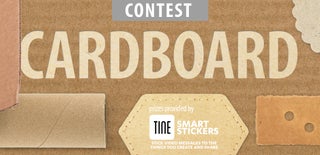Introduction: Cardboard Kitchen Cupboard Organizer
Ever since we moved into our apartment, we've had a kitchen cupboard stuffed full of all the odds and ends that wouldn't fit anywhere else. I always wanted to tackle this mess, but frankly kept putting it off. Once I finally worked up the motivation to start, I decided to use cardboard to create an organizer as I thought perhaps it would make the construction easier and quicker. As it turns out, cardboard isn't as easy to work with as I thought, but I was still able to accomplish what I set out to do. Let's get started.
Step 1: What I Used
The materials for this build are very limited:
Cardboard (I picked up from the dumpster)
Glue (I used Elmer's wood glue, but lots of glues would work)
Wood Filler
Spray Paint
The tools needed are also quite simple:
Ruler
Knives (X-Acto, utility knife, and/or razor blade)
Bending Brake (Ok, so this is totally unnecessary, but I had one that I just made)
Heavy Duty Paper Cutter (Also not necessary, but saved some time)
Small Clamps
Heavy Books
Trough for Wood Filler
Sand Paper
Step 2: Remove Stuff and Organize
The first step was to remove all of the stuff from the cabinet and organize it. This allowed me to easily see what I was working with and also get an idea of how many compartments I would need in the finished organizer.
Step 3: Measure Everything
Next everything was measured. This included the space into which the organizer needed to fit as well as getting general sizes of the stuff being organized. As I continued in the design, I had to re-measure and re-organize the stuff to ensure that it would all fit into the organizing slots being prepared.
Step 4: Design
I designed the organizer in Sketchup, which made it easy to ensure that everything worked out in 3D. It was designed around 1/8" thick corrugated cardboard that I picked up in the dumpster. I've attached the Sketchup file if you want to take a more in depth look at the design.
Attachments
Step 5: Design Elements
Rather than going in depth into the design, I think it's more beneficial to point out several design elements that I used for joining the pieces of cardboard together. First, I decided to double up the cardboard for the entire structure, which added significant strength to the design.
Since the weak points of this structure would be the 90° joints between the pieces, I decided to recess all of the joints. In the figures above you can get an idea of the three types of joints I used. The double layer recess joint is the preferred joint, unless there was some other design constraint dictating that the single layer joint be used. The staggered recess joint was only used at one location, where joints needed to be made on both sides of a single vertical support.
Long pieces of cardboard were bent to form the outside of the organizer as this prevented joints at the corners, which would only have been supported on one side. I'm sure there are better ways of joining up cardboard, but this is what I came up with off the top of my head.
Step 6: Convert the 3D Design to 2D
I carefully worked through my 3D Sketchup design and converted it into a 2D drawing of all of the cardboard pieces needing to be cut and/or bent. I used CorelDraw to generate this 2D drawing, which was simply printed and used as a reference as I cut out the pieces.
Attachments
Step 7: Cut Cardboard
All of the cardboard pieces were marked and cut using several different methods. For straight cuts less than 12" in length, I was able to use a heavy-duty paper cutter, which surprisingly made a pretty decent quick cut. For longer cuts, and those that were more intricate, I used a combination of a razor and/or utility knife. The trickiest cuts were the curved bits for the rolling pin holder, but these were easily made using an X-Acto knife.
Step 8: Bending
Several pieces needed to be bent. I used my sheet metal bending brake for this. I'll admit this is a bit overkill, and you could accomplish the same thing by bending around the edge of a table, but I just made the brake and it actually worked really well in making nice square bends in the cardboard.
Step 9: Start the Glue Up
I used Elmer's wood glue to glue everything together as it's what I had on hand. I wish I had used something that would've set up a bit quicker, but Elmer's glue isn't bad as you only need to clamp the pieces for a half hour.
I started the glue up at the bottom corners of the organizer and slowly worked upwards and inwards throughout the following steps. The exact order you take isn't terribly important so long as you can still assemble everything as you go along.
Step 10: Continue the Glue Up
I gluing up the bottom and sides of the organizer. The center support was added, followed by the lower level support and shelf located to the left of the center support. Next, the vertical supports and shelf to the right of the center were fitted.
Step 11: Finish the Glue Up
With all of the vertical supports fitted, the wide upper shelf was glued in place, followed by the top piece of the organizer. For the shelf and top, small clamps were used in addition to the books to help hold everything together as the glue set up. Note that these clamps aren't really tightened down as they would crush the cardboard. I simply tightened them to the point where the two pieces of cardboard were in contact with one another.
Step 12: Seal Front Edge
To give the organizer a more finished look, I sealed the front edge with wood filler. This actually took quite a bit of wood filler as I had to fill in a lot of corrugations.
Step 13: Final Finishing
Once the wood filler set up, I sanded it smooth with 320 grit sandpaper and painted the entire organizer with white spray paint. I wasn't quite sure how spray paint would work on cardboard, and I was a bit disappointed with the result. Cardboard really soaks up the paint, which meant I had to apply a liberal amount of paint. I ended up using the entire can on the organizer and the coverage was barely sufficient. It may have been better to paint with a brush, but I'm assuming this is just one of the drawbacks inherent to finishing cardboard.
Step 14: Organize
The final step was to put everything to be organized into it's slots and enjoy my newly organized cabinet.
For the most part I am pleased with how this project came out, but there are several changes I would make if I were to do it again. While using cardboard was an interesting experiment, and it worked out from a structural standpoint (the organizer is super solid), it comes with two drawbacks. First, I found that cutting, bending, and gluing the cardboard wasn't as easy, quick, or accurate as I hoped it to be. I imagine that some of these issues could be resolved by better techniques, but for the amount of work and time spent I feel like I should have just used 1/4" plywood. Second, as I mentioned previously, painting the cardboard proved to be problematic. In some ways I preferred the unfinished cardboard to the painted cardboard. You expect cardboard to not look perfect, but adding paint to it requires that it look like something better than cardboard, which it really doesn't.
Despite these misgivings in the finished product, I'm still happy with my newly organized cabinet and learned a lot from this project.

Second Prize in the
Cardboard Contest 2016

Participated in the
Dorm Hacks Contest 2016















